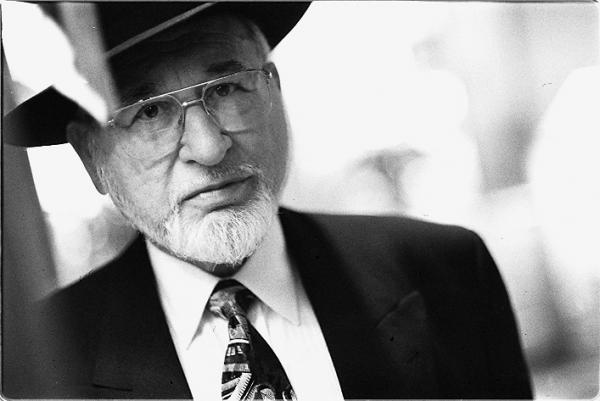In Memoriam: Ben Zion Shenker (1925–2016)

November 21, 2016
Singer, composer, collector of Hassidic niggunim was "a living library of song"
Ben Zion Shenker, renowned singer, composer, and collector of Hassidic niggunim, has died. He was 91 and lived in Brooklyn, New York. Inspired by Rabbi Saul Taub, rebbe of the Polish Modzitzer Hassidic dynasty, Shenker dedicated much of his career to documenting and performing Modzitzer niggunim. He also composed more than four hundred original songs in the European Hassidic fashion.
“We are saddened by the passing of Ben Zion Shenker,” said Milken Archive of Jewish Music founder Lowell Milken. “He was a living library of song and an irreplaceable link in the history of Hassidic music. We are grateful for the work he has done to preserve Jewish heritage.”
Shenker was born in 1925 in Williamsburg, Brooklyn to parents who had recently emigrated from a small town near Lublin, Poland. His earliest musical exposure was to the Hassidic melodies that his mother sang and to the hazzanut he heard as a child in synagogue. He also recalled how at the age of three or four his mother would sit him down in front of the family’s Victrola player with stacks of records by the great cantors. At the age of twelve, Shenker was invited to join cantor Joshua Samuel Weisser’s synagogue choir, where he became the alto soloist. Weisser had noticed the boy’s aptitude for singing hazzanut with traditional colorations and not only gave him solos, but also wrote new ones especially for him.
Though his family belonged to the Trisker (Chernobyl) dynasty, Shenker was introduced to Modzitzer repertoire at the age of 15 when he heard the rebbe sing at a service in Brooklyn. Rabbi Saul Taub, a refugee from Poland who had resettled in New York in the early 1940s, was known for his inspired devotional melodies and affecting performances. In the Hassidic tradition, song is a vehicle for ecstatic union (hitlahavut) with the divine, and Shenker was entranced.
When, by chance, R. Taub heard Shenker singing niggunim from a book of Hassidic music, the rebbe took the young man on as his musical secretary. Shenker would eventually notate more than 100 of the rebbe’s original songs and would go on to learn, by his own account, about 1,000 niggunim from the Modzitzer tradition. Shenker also composed many original pieces in the European Hassidic style, ranging from simple songs to multi-movement operes.
Shenker recalls how he became R. Saul Taub's musical secretary.
The problem of memorializing and transmitting such a vast repertoire—much of which belonged to oral tradition—became the focus of Shenker’s professional life. “If you don’t sing them, you forget them,” he told the Jewish Press. As a bulwark against forgetting, he and his friends would gather to sing songs between Passover and Sukkot and on the yarzheit of each Modzitzer rebbe. But he was also concerned with more durable forms of preservation.
Founding Neginah Records in 1956, Shenker made some of the earliest commercial recordings of Hassidic niggunim in the United States, including Modzitzer Melave Malke Melodies, Modzitzer Sholosh R’golim, and the multi-volume Modzitzer Favorites. His recordings of Modzitzer repertoire have inspired similar preservation efforts among the other Hassidic dynasties that settled in New York, such as the Lubavitcher, Gerer, and Bobover, all of whom have gone on to release their own recordings.
An ordained rabbi, Shenker made his living in the garment and jewelry business while he wrote and recorded music. He also served for nearly six decades as cantor of a Modzitzer synagogue in Brooklyn.
Many of his original songs are now considered standards. His most widely known composition is “Eshet ḥayil” (1953), a setting of text from Proverbs typically said on Shabbat in praise of one’s wife. It is featured in Milken Archive’s Volume 6, Echoes of Ecstasy: Hassidic Inspiration in an arrangement by Stanley Sperber, founder of New York’s Zamir Chorale. Other well-known compositions include “Mizmor l’david” (1946), a setting of Psalm 23, and “Yasis alayich” (1965), a setting of verses from the liturgical song “L’kha dodi.”
Called the “the greatest living figure of Hassidic music” by NPR, Shenker continued to write and record new music throughout the course of his long career. “I compose new music every year,” he told the radio network in 2013, noting that he had just composed seven new melodic settings for texts used on Rosh Hashanah and Yom Kippur. His most recent album with mandolin and clarinet virtuoso Andy Statman, Shiru Lashem, was released earlier this year.
The Milken Archive of Jewish Music mourns the loss of Ben Zion Shenker. May his legacy of song continue to uplift and inspire.
